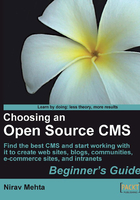
Installing a CMS
Before we can add content to our site, we must set up the CMS. Installing a CMS can be too technical; especially if this is the first time you are setting up a web site. Most CMSs try their best to make the installation process easy and as automated as possible. Many hosting companies have CMS systems available from their control panels for easy installation. If your host allows this, you can go ahead and install a CMS using its control panel.
Before the installation
Setting up a CMS typically involves these steps:
- Downloading and unzipping CMS files
- Creating a new database on your web site and creating database username and password
- Updating database name, username, and password in configuration file(s)
- Uploading CMS files to your server via FTP
- Going to the CMS's installation page and following on-screen instructions
If you are new to installing things on your web site, you should review the following tutorials before the installation.
Plesk and cPanel are popular web-based control panels. Here are some tutorials that explain how you can create a new MySQL database using cPanel or Plesk:
FTP stands for File Transfer Protocol, and is a way to upload files from your computer to your host's server. Refer to these tutorials for some very good background information and instructions on using FTP tools.
phpMyAdmin is a popular tool to manage a MySQL database over the Web. You should get familiar with phpMyAdmin for installing your CMS and troubleshooting any small issues.
Uploading images and other media via CMS may require permissions to write to a folder on the web server. This will require that you understand some basics of file permissions on Linux/Unix servers. Here are two great resources to learn this:
Alright, we are now ready to install WordPress.